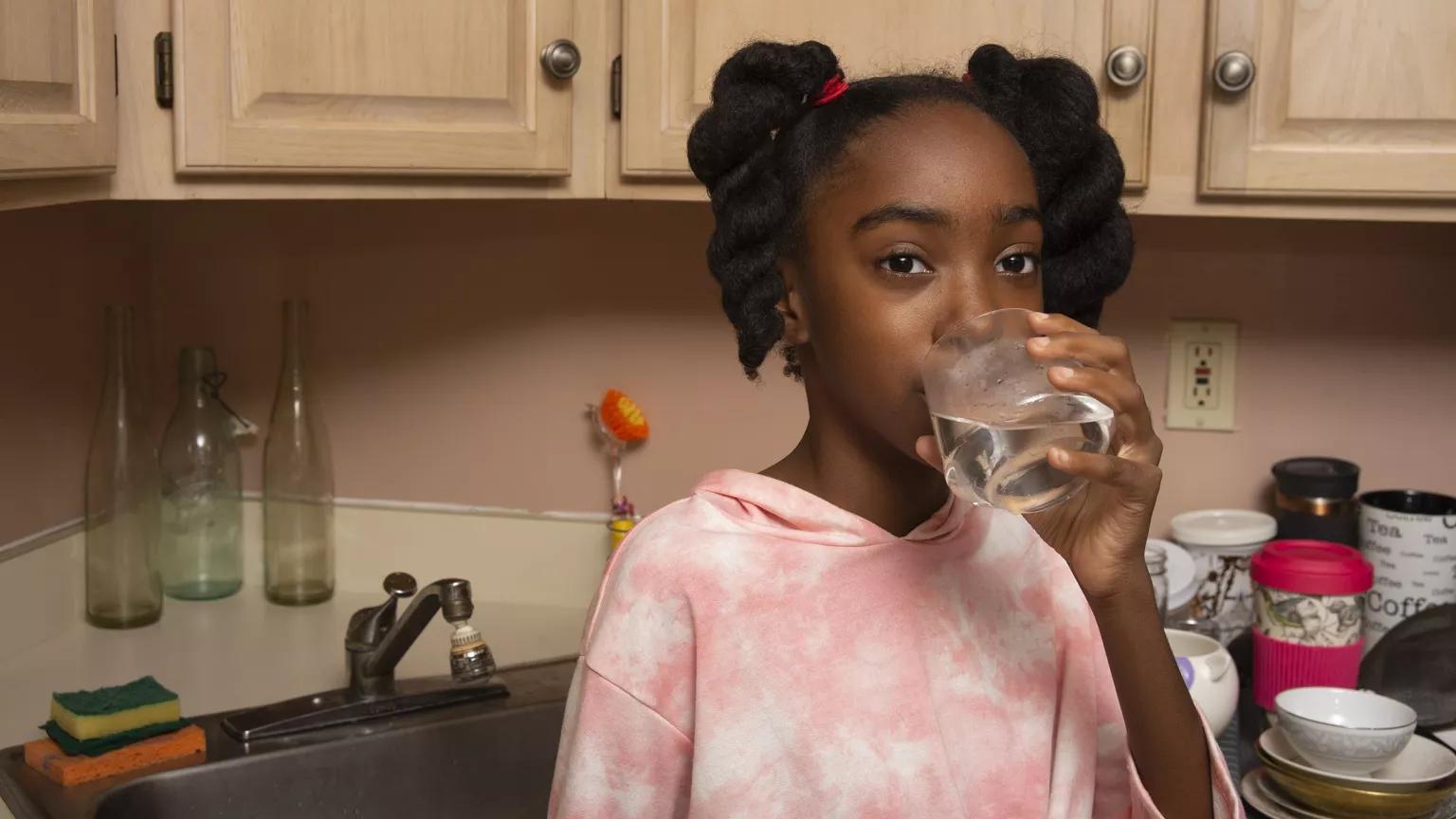Protecting Public Health
NRDC strengthens its focus to safeguard disadvantaged communities from exposure to pollution and toxic chemicals.

Shima Green for NRDC
The fight for safe water, clean air, and a healthy home has never been more urgent, especially for BIPOC (Black, Indigenous, and people of color) and low-income communities. In the past year, NRDC increased our dedication to these goals through the creation of two new divisions. The new Science Office—led by NRDC’s first-ever chief science officer Kristi Pullen Fedinick—will serve to better integrate science with our advocacy work. And the Environment, Equity & Justice Center, headed by our first chief equity and justice officer, Melissa Lin Perrella, will focus on the integration of equity into NRDC’s policy advocacy and enhance our ability to advance community-driven solutions in partnership with frontline groups. NRDC’s commitment to help those overburdened by environmental injustice remains unwavering.
Exposing Water Injustice
To tackle the problem of toxic lead in U.S. drinking water, we need to replace every lead pipe. To that end, NRDC has urged policymakers to ensure the removal of lead service lines within the decade—prioritizing action in disadvantaged communities—and to set a strict at-the-tap standard for safe water.
Through the Build Back Better agenda that NRDC has championed, President Biden has called for $45 billion to replace lead service lines over the next 10 years. Erik D. Olson, NRDC’s senior strategic director for health, notes the investment of $15 billion enacted in the bipartisan infrastructure deal, combined with $10 billion in other funding from the now-pending Build Back Better Act, would represent “the most significant funding for removing lead from drinking water in U.S. history.”
At the same time, we have urged the U.S. Environmental Protection Agency (EPA) to fix the woefully inadequate Lead and Copper Rule—which would leave millions exposed to contaminated water for decades—and filed a lawsuit challenging the rule in January. While the EPA decided in December to leave the rule in place, it promised to overhaul and strengthen it by 2024, and announced major funding toward the removal of lead service lines across the country. Taken together, these two actions would largely eliminate the scourge, said Olson. NRDC will continue to call for the agency to deliver enforceable requirements and fulfill President Biden’s commitment to solving the lead crisis.
Drinking water emergencies like those in Flint, Michigan, and Newark, New Jersey, as well as elsewhere underscore the need to invest in solutions now. Research led by Pullen Fedinick showed that 186 million people in the country—a staggering 56 percent of our population—drank water from systems with lead levels exceeding that recommended by the American Academy of Pediatrics to protect children. And NRDC and environmental justice partner groups have revealed that when it comes to safe drinking water in America, race still matters. Communities where people of color make up higher percentages of the population are more likely to have drinking water systems in violation of the law, and to experience an inadequate response to the violations. Another recent report has shown that wealthier white communities are more likely to benefit from lead pipe removal programs than are low-income communities of color.
These injustices are clear to advocates in Benton Harbor, Michigan, just two-and-a-half hours west of Flint, where tests found lead levels in some areas as high as nearly 60 times the federal standards. Of Benton Harbor’s 10,000 people, 90 percent are people of color and 45 percent have an income that is below the federal poverty level. The town’s grassroots advocates, supported by NRDC and other allies, have drawn national attention to the crisis, which has been ongoing for at least three years. And in September, we joined a group of 20 Michigan-based and national organizations to file an emergency petition with the EPA to secure a removal of all lead service lines and to provide free bottled water for the community until at least six months after the lead pipes are removed. We succeeded in getting the bottled water, and Michigan Governor Gretchen Whitmer has committed to removing the lead pipes within 18 months.
Delivering Safe Water in Schools
Advocates have also pushed for the removal of lead in drinking water from the taps in schools—the places where children spend the most time outside of their homes. As senior attorney Joan Leary Matthews points out, “If we fix the problem with lead lines in our homes, it’s counterproductive to send our kids to schools and childcare centers that still have a problem with lead in their drinking water.” President Biden has addressed the urgency of tackling this issue and notes that his planned investments in infrastructure will reduce lead exposure in 400,000 schools and childcare facilities.
Meanwhile, NRDC has urged states to take action on the issue through a “Filter First” approach that requires the installation of filters or fixtures with filters, to be followed by testing. Washington, D.C., is implementing this Filter First policy, and NRDC has developed model legislation that includes it. To prove its affordability, NRDC also conducted a cost analysis for Michigan schools, which has been used in a bipartisan bill that’s now before the Michigan Legislature.
Meanwhile, in New York—where analysis of data in 2016 has shown that around 82 percent of public schools have reported one or more taps testing above the state lead action level of 15 parts per billion—progress has been made through a new bill signed into law in December by Governor Kathy Hochul. The legislation will make certain that schools test every three years at 5 parts per billion and provide alternative water, if necessary, to students and staff at no cost to them. The data analysis and advocacy that led to this important victory for students, school staff, and families of New York was the product of years of work by a coalition of partners, with NRDC playing a leading role in conducting research, meeting with legislators, signing onto letters, and amplifying the cause on social media.
Addressing Water Bill Affordability
Alongside our work combatting the lead crisis, NRDC is urging policymakers to protect access to safe water for families struggling to pay their water bills. Before the pandemic hit, tens of millions of people—mostly people of color experiencing poverty and unemployment—already faced the chronic threat of water shutoffs due to unaffordable bills. In 2016 alone, an estimated 15 million people experienced water shutoffs for nonpayment. And in the past two years, the problem has worsened. What’s more, Black and Latino communities already suffering higher rates of infection and death rates due to COVID-19 are at disproportionate risk of utility shutoffs as well.
To help fight this injustice, in 2021, we worked with frontline partners in multiple states to secure the extension of water shutoff moratoria, which were first put in place at the start of the pandemic—and which have been proven to save lives. Together, we also secured more than $2 billion in federal and state funds for water customer debt relief. NRDC is currently joining with our partners in calling for a permanent federal program to fund low-income household water assistance, and for permanent protections for people who can’t afford their water bills. Advocates are seeing success toward these goals on the state level: We recently secured a first-in-nation annual winter ban on shutting off water service to low-income households in New Jersey.
Banishing a Highly Toxic Pesticide
“We will continue to hold the EPA accountable to ensure children are protected from pesticides.”
Miriam Rotkin-Ellman, senior scientist, People & Communities Program
NRDC has been fighting for more than two decades to get chlorpyrifos out of our food supply. Studies have shown that this widely used chemical poses high risks to children, especially in agricultural communities. In recent years, the back-and-forth legal battle heated up after the Obama administration proposed a total chlorpyrifos ban in October 2015, and then the Trump administration reversed the decision in 2017—without new evidence and as part of a pattern of handouts made to industrial groups (in this case, the main beneficiary was the chlorpyrifos manufacturer Dow Chemical). In the end, science—and an administration unwilling to ignore it—prevailed. In response to a lawsuit brought by NRDC and a coalition of labor and health groups represented by Earthjustice, the U.S. Court of Appeals for the Ninth Circuit found the Trump administration’s delays to be illegal and ruled in April that the EPA needed to either issue the ban or, alternatively, show the chemical could be used safely, as is required under the law. After the ruling, more than 35,000 NRDC activists sent letters urging the agency to ban chlorpyrifos from our food once and for all. On August 18, the agency made it official.
Battling a Notorious Polluter on Chicago’s Southeast Side
In 2020, when General Iron—a metal shredding plant—announced plans to move its operations from the affluent community of Lincoln Park to a working-class community of color on Chicago's Southeast Side, the response was immediate. General Iron had been found liable for violating the city's environmental codes, it has been responsible for dangerous explosions and fires, and it has been shut down repeatedly for public health violations. What’s more, the Southeast Side is already overburdened by industrial pollution and the facility’s proposed new location was near an elementary school and high school. Many rightly viewed the action as a clear case of environmental racism.
Backlash was fierce, and included protests and steady public outreach by a coalition of community groups and NRDC. Through social media, e-mail, and SMS alerts, we urged our Illinois supporters to sign our petition and to contact city officials to stop the project. Collectively, NRDC activists responded by sending thousands of public comments and letters and making hundreds of phone calls to decision makers. We also partnered with Brut media on a video and with Patagonia and Provoke Culture on a protest mural to spark dialogue and catalyze local action on behalf of the cause.
Among the chief local organizers was NRDC’s Midwest outreach manager Gina Ramirez, who is also a member of the Southeast Environmental Task Force. In May 2021, its advocacy led to a major win: Chicago officials announced that the city would stop the permitting process that would have allowed General Iron to relocate. To Ramirez, it was a critical first step, and a wake-up call for the city to do more. “What we need next is real reform over how land use permitting decisions get made and who gets to make them,” she said. “Impacted communities need a seat at the table—and conversations must prioritize public health, not profits.”
Protecting Millions from Toxic PFAS Chemicals
In September, California Governor Gavin Newsom signed a law to protect Californians from toxic “forever” PFAS (per- and polyfluoroalkyl substances) chemicals. Specifically, the legislation bans the use of PFAS in paper-based food packaging, requires disclosure of chemicals of concern in cookware, and prohibits misleading advertising about the presence of these chemicals in cookware.
The bill was cosponsored by NRDC with Breast Cancer Prevention Partners, Center for Environmental Health, Clean Water Action, and Environmental Working Group. NRDC took a leading role in negotiating with industry, which initially opposed the bill, to secure its neutral position—a key factor in the governor’s decision-making.
The action taken by California follows years of NRDC advocacy on toxic chemical reform and comes after a recent report that highlights inequity in exposure to PFAS pollution in drinking water. Notably, while this problem is widespread throughout the state, it is more intense in communities already overburdened by other sources of pollution. Indeed, at least 69 percent of state-identified disadvantaged communities have PFAS contamination in their public water systems. Others at high risk from exposure to these toxic chemicals, who will benefit the most from the ban, include the workers making PFAS-containing products, the consumers using them, and the communities living near their production or disposal sites. Because California constitutes such a large part of the national and international economies, the new law will also be a significant factor in shifting the broader market away from PFAS in paper-based food packaging, especially when combined with a similar law NRDC helped win in New York.
Eliminating Toxic Chemical Flame Retardants in New York (and Beyond)
In June, the New York legislature passed the Family and Fire Fighter Protection Act, which will broadly ban toxic flame retardants in furniture and mattresses. Advocates see the law as essential to closing regional gaps in the national market for these products; California and Maryland have already passed similar laws. The legislation also makes New York the first U.S. state to ban particularly persistent organohalogen flame retardant chemicals in the stands and enclosures of larger electronic displays, following the lead of the European Union. Firefighters and children face especially high risks from flame retardant chemicals, which are linked to myriad health effects, including cancer, reproductive problems, and reduced IQ.
Firefighters strongly supported the bill, along with the coalition of environmental health groups, including NRDC, Clean & Healthy New York, Earthjustice, JustGreen Partnership, and others. And as 2021 wound to a close, Governor Hochul signed it into law.
More Highlights from 2021

Advancing Clean Buildings and Transportation

Building a Healthier Food System

Advancing Global Climate Solutions

Championing Conservation as Climate Action

Time to Go Big
Check out the rest of our annual report for an overview of what we've accomplished in 2021.







